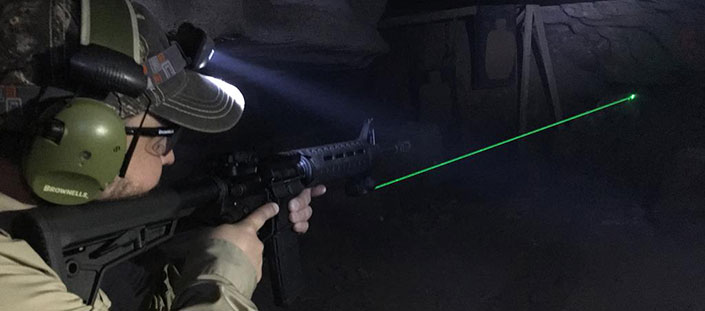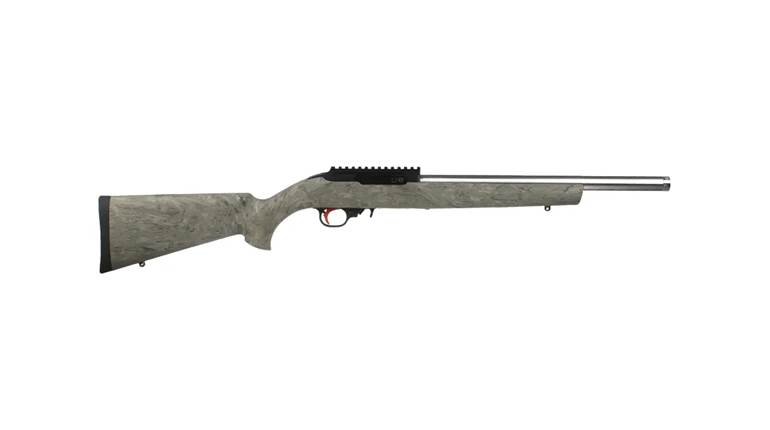
At times, much of the new and highly advertised shooting accessories arriving on the market are not actually all that new. They may be shorter, longer, faster or better than their predecessors in some way or another, but they are still essentially the same thing. In the case of laser and light modules for tactical rifles, the diodes and LEDs keep getting brighter, the batteries are lasting longer and the housings are becoming smaller. But despite these tangible improvements to the products, laser and light modules have continued to drag their tails behind them in the form of flat, tape-style control switches attached with lengths of cumbersome curling wires. In other words, this cutting-edge, digitally enhanced, 21st century illumination technology still uses a land line to tether the operator to his device.
Recognizing the need for a better, more up-to-date way of managing lights and lasers in the field, Crimson Trace set out to develop the very first wirelessly controlled sighting system for AR-pattern rifles. But eliminating the drag line wasn’t enough. The system would have to be rugged enough for real-world operations, reliable in a variety of environmental conditions and free of the frailties that hamper the use of some wireless technologies. Hundreds of hours of design work and testing have resulted in the Crimson Trace LiNQ system.
The first concern that crops up with any new shooting technology is whether or not it will stand up to the rigors of everyday use and abuse. According to Eric Petterson, director of engineering, “LiNQ represents one of the most significant and rigorous product development efforts in the history of Crimson Trace. This system is one of the most ruggedized accessories you can install on your [modern sporting rifle] … other furniture, and the firearm itself, broke in drop testing before LiNQ did.”

The system is compatible with a variety of popular platforms, including AR-15, AR-10, M4 and HK416 variants. The system consists of two primary components: a rail-mounted laser/light module and a specialized AR-style control grip. The wireless connection between the two components is not Bluetooth, but a similar type of proprietary encoded radio frequency signal developed by a software company for the LiNQ. According to Petterson, “The 256-bit encryption inherent to this technology helps ensure that this system remains secure and functions as expected each and every time it is needed.”
This wireless technology has been carefully tested to ensure it cannot be hacked or overpowered by conventional methods. A unique encrypted bond, or pairing, is established at the factory. The “code” for the pair is stored in the memory of both units and will not be erased or reset when the batteries are removed and replaced. Once the pairing process is completed, the grip and the laser unit will interact only with each other. Because LiNQ is a closed system, it’s not electronically accessible to other wireless devices.
The light/laser module is built into a rugged, waterproof (IP58 rating), hard-anodized aluminum housing designed to handle a good deal of abuse. The integral rail mount (wrench included) allows the module to be attached to M1913 Picatinny, or similar, accessory rails that are at least 2.75" long. The three-LED, 300-lumen flashlight is combined with a green laser diode that can operate in four modes, including: laser only, light only, laser with light and laser with strobe light. While other companies opt to use less expensive plastic lenses to cut costs, Crimson Trace installs a glass lens in the LiNQ system. This ensures a bright, focused laser dot downrange instead of a blurry or misshapen point. A tool is provided to adjust the laser for both elevation and windage.
A front-mounted, removable cover allows the module’s single CR123 battery to be replaced without removing the unit from the rifle rail. A large, rear-mounted switch allows the module to be activated and to cycle modes independently of the grip in case the grip unit’s battery runs out of power.
The control unit is housed in a polymer AR-style grip constructed of impact-resistant polymer and is certified as waterproof (IP67 rating). It fits most AR lowers and takes its general design cues from the classic A2 grip, so it looks and feels familiar to AR fans. The sides have an aggressive texturing reminiscent of skateboard tape, with raised-line texturing along the frontstrap and backstrap.
The round activation button is located on the front of the grip where it’s depressed by the middle finger of the shooting hand when the operator forms a shooting grip. There is a slight finger bump just below it. Recessed right- and left-side Mode Selector buttons are located at the top of the grip, above the aggressive texturing, with green LEDs below them that flash when the batteries are low on power or when the grip and laser are in the process of pairing. On the bottom of the grip is a removable cover for the single CR2 battery and a tethered rubber plug that protects the grip screw channel from moisture and dirt. A master “On/Off” switch is located on the lower left side.

Installing the LiNQ control grip follows the same steps as installing other aftermarket grip upgrades. After verifying that the rifle is completely unloaded, and turning it upside down, remove the original grip’s attachment screw. Be sure not to drop or lose the safety selector detent or spring as the grip is removed. Pull the rubber plug from the LiNQ grip and then use the Allen-head screw and long hex wrench provided with the LiNQ system to attach it to the lower receiver. Replace the rubber grip plug, install the battery and the grip control is ready to use.

To cycle the system’s modes, start with the laser module off and ensure the grip’s master power switch is in the “On” position. Depress and hold either the right- or left-side selector switch on the grip first and then depress the grip’s front-facing instinctive-activation switch. While holding both buttons down simultaneously, the module will cycle through the four modes until the buttons are released. This is easily accomplished using the thumb of the shooting hand to hold the “Mode Selector” and the middle finger of the shooting hand to hold the activation button.
The LiNQ’s typical operational battery life is two hours of constant-on illumination. The system has an automatic illumination shut-off that kicks in after five minutes to conserve power. However, the module and grip continue to be in constant radio contact with each other to provide instant activation when needed. The radio signal only draws a minute amount of energy from the batteries when the system is not in use. The LiNQ will eventually shift into a radio “sleep” mode to conserve even more power when left unused for long periods of time. A tap to both the module and grip activation switches will wake the system up and re-establish the radio link. Crimson Trace recommends changing out both LiNQ batteries every year to ensure peak performance. The LiNQ system ships with a standard Crimson Trace three-year warranty and qualifies for the company’s exclusive Free Batteries For Life program.

Near the end of August, when the LiNQ was officially released, I had the opportunity to gather with a handful of industry writers at the Rockcastle Shooting Center in Park City, Ky. With its knobby terrain above and winding cave systems below, Rockcastle proved to be an ideal testing ground for the system. Our group spent two days putting a few factory-fresh LiNQs through their paces using Smith & Wesson Model M&P15 MOE Mid Magpul-series rifles chambered in 5.56x45 mm NATO (.223 Rem.) as test platforms. We also spent some quality time with a compact 9 mm Luger Smith & Wesson Shield, Glock G43 and Springfield XD fitted with Crimson Trace Laserguard sights.
We engaged rifle and handgun targets at a hillside two-gun course during the day. Moving as quickly as possible up a muddy slope, we engaged high and low targets (some partially concealed) while switching guns and performing tactical reloads. Exercises like this provide a useful perspective of the real-world conditions one might have to contend with in a defensive situation. At night, we switched over to a traditional flat range IPSC/IDPA type course. The ambient light conditions on the shooting range varied from low-light to no-light. With the light and green laser activated, the LiNQ provided a clear, unmistakable view of each and every target to be engaged.
By far one of the most unusual and informative training experiences available at Rockcastle is “shooting the cave.” Due to the rough roads in that area, the cave entrance can only be reached via a four-wheeler. After a short walk in the woods, we bear crawled through a narrow opening in the earth.
Once inside, we lined up at the beginning of an absolutely pitch black, 800-ft. limestone corridor that twisted and turned in unpredictable ways. We were informed that this particular cave was selected for use as a practical firearm course because it was uninhabited by bats or other wildlife that thrive in other protected caves on the property. Specialized individual bullet stops were hung behind every target to ensure our safety.
The targets were set high and low with the only illumination provided by the LiNQ’s light and the operator’s headlamp. The porous walls had a strange way of absorbing sound. The gunsmoke hung in the air, giving it a hazy, almost foggy quality. Unlike a typical shoot house, the floor of the cave was uneven and inconsistent, forcing us to pay close attention to our footwork. The rough stone walls grabbed at clothing and gear if we moved too close. The alien landscape and utter darkness drove a level of concentration that was focused, to say the least. Despite the muddy conditions, humid weather and high round counts, the LiNQ proved to be a reliable shooting companion.
The new Crimson Trace LiNQ system is remarkable among today’s long gun laser sight offerings because its wireless controls allow it to blend so seamlessly into the AR platform to which it is attached. Like the company’s other instinctive-activation Lasergrips, the LiNQ system is up and running the moment the operator grasps the grip—no fuss, no muss, just reliable illumination and laser sighting—without the hassle of support-hand activation switches or looping cables.
The system is rugged, reliable and ready to go to work in the harsh conditions so commonly faced by law enforcement and military personnel. This means it will easily stand up to regular use in civilian hands, including competition and home defense. The LiNQ’s modularity extends beyond its outward design. Should either the grip or laser module be damaged or lost, the remaining component can be repaired with a replacement part. It’s a system that rightfully deserves to be touted as the latest and greatest option in its class.







































